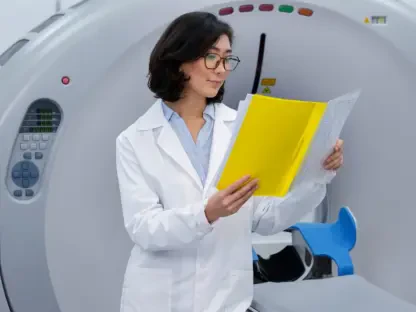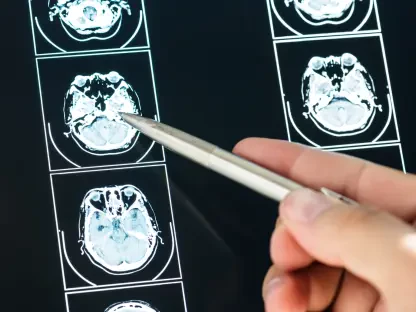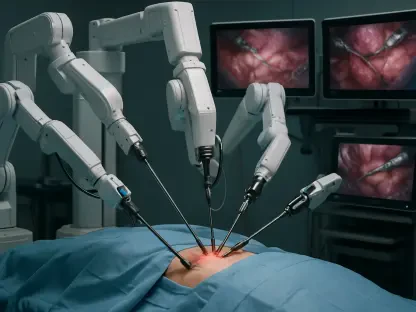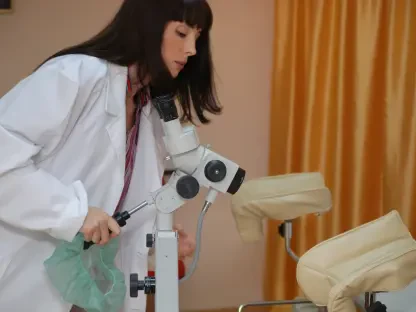Nuclear medicine stands out in the realm of diagnostic healthcare, offering unique insights into the body’s microscopic functions. By harnessing the power of radiotracers—radioactive substances that travel through the body—it reveals vital information right down to the cellular level. This innovative technique is particularly effective for early detection of diseases, providing critical information before ailments fully manifest. These radiotracers emit energy captured by special cameras and computers to create detailed images of the structures and processes within the human body. As a result, nuclear medicine helps clinicians to pinpoint various conditions, including cancers, heart diseases, gastrointestinal, endocrine, and neurological disorders, often much sooner than with other diagnostic methods.Moreover, nuclear medicine isn’t limited to imaging; it also encompasses targeted therapeutics. For example, radioactive iodine therapy is a common treatment for overactive thyroid conditions. This treatment employs radiotracers to deliver therapeutic radiation directly to the diseased organ, minimizing the impact on surrounding healthy tissues.With continuous advancements, nuclear medicine is expanding its capabilities and precision, thus underscoring its indispensable role in modern healthcare. As new radiotracers and imaging technologies develop, the potential for earlier diagnosis and targeted treatment strategies grows, fundamentally changing how medicine diagnoses and treats disease.
Understanding Nuclear Medicine
The Role of Radiotracers
Radiotracers, or radiopharmaceuticals, are central to nuclear medicine procedures. These substances are specifically designed to target certain organs, bones, or tissues by binding to specific biological markers. Once introduced into the body, they emit radiation that can be detected and visualized with specialized imaging equipment. The remarkable aspect of radiotracers is their ability to highlight physiological processes and anomalies which could indicate the presence of disease. For example, fluorodeoxyglucose (FDG) is a glucose analog labeled with a positron-emitting radionuclide, which—when used in PET scans—is absorbed by high-energy cells like cancer cells, rendering them visible on the scan.The radiotracers used in nuclear medicine are meticulously crafted to ensure they are safe for patient use. Before they are administered, a thorough evaluation of the patient’s health status is conducted to minimize any potential risks. The doses of radiotracers are carefully calculated to be effective for diagnosis while limiting radiation exposure to the patient.
Mechanism of Imaging Techniques
Nuclear medicine imaging techniques such as PET and SPECT are instrumental in providing high-detail images that are critical for accurate diagnosis. These techniques rely on the detection of gamma-ray emissions from the radiotracers within the patient’s body. In PET scans, positrons emitted by the radiotracer interact with electrons, resulting in the emission of two photons that are detected by the scanner to create a three-dimensional image. SPECT, on the other hand, captures gamma rays directly with a gamma camera that rotates around the patient to yield images from various angles. These methods allow clinicians to assess not just the anatomy but the functionality of organs and tissues, giving a comprehensive view of a patient’s health.The imaging process typically requires the patient to remain still for a period of time while the camera does its work. In some cases, multiple scans may be needed to monitor the radiotracer’s distribution and gather valuable data regarding the body’s metabolism and chemical activity. The effectiveness of these imaging techniques hinges on the precision with which the radiotracers localize in specific areas, revealing vital information about the body’s inner processes.
Diagnostic Applications of Nuclear Medicine
Detecting and Staging Cancers
In the realm of oncology, nuclear medicine proves indispensable. It’s particularly potent for staging cancer, gauging the spread and activity of malignant cells. For instance, PET scans display the metabolic activity of tissues, making them adept at spotting tumors that are actively growing and consuming glucose at a higher rate. Similarly, bone scans using radioactive technetium can unveil metastases to the skeleton, often before they’re visible on X-rays.The information gathered from these scans doesn’t just pinpoint the location of cancers; it also contributes to formulating the most fitting approach to treatment. For diseases like lymphoma or breast cancer, doctors may choose specific therapeutics based on the stage and location of the tumor, which is often determined by the nuclear medicine studies. The ability to visualize the entire body allows for a comprehensive assessment of tumor spread, making such scans a cornerstone in cancer management.
Cardiovascular Disease Assessment
For cardiac conditions, nuclear medicine steps in to fill critical diagnostic roles. Myocardial perfusion imaging, for instance, is a stress test that uses radioactive tracers to capture images of the blood flow to the heart both at rest and during exertion. This dichotomous imaging helps identify areas where blood flow is compromised, signifying possible coronary artery disease.Another prominent use is in the evaluation of heart muscle function post-myocardial infarction. Techniques such as MUGA (multigated acquisition) scans generate precise measurements of the ejection fraction, helping doctors determine the extent of damage and plan further management. The dynamic nature of these studies allows for an assessment that mirrors real-life physiology, which is integral to a comprehensive cardiac workup and could not be replicated by static imaging modalities.
Evaluating Neurological Disorders
Neurological disorders present intricate puzzles, and nuclear medicine provides unique insights. By observing the brain’s glucose metabolism through PET scans, clinicians can detect patterns indicative of Alzheimer’s disease long before symptoms become noticeable. In Parkinson’s disease, certain radiotracers pinpoint the activity of dopamine-producing neurons, which are less active in affected individuals.Furthermore, for epilepsy patients, nuclear medicine can capture the metabolic changes that occur during seizures, often allowing for localization of the seizure focus in the brain. This is vital for surgical planning, especially when other imaging techniques have failed to yield definitive results. Nuclear medicine thus enhances our understanding of and capacity to treat an array of debilitating neurological diseases.
Therapeutic Uses of Nuclear Medicine
Radioactive Iodine I-131 Therapy
Radioactive iodine therapy stands as a prime example of how nuclear medicine has revolutionized the treatment of thyroid-related conditions. This form of therapy harnesses the thyroid gland’s intrinsic property of iodine absorption. By administering I-131 orally, it is naturally drawn to and concentrates within thyroid tissues. Its therapeutic efficacy particularly shines in the treatment of hyperthyroidism and thyroid cancer.Once thyroid cells, including cancerous ones, take up the radioactive iodine, they are subsequently destroyed by the beta radiation emitted from the iodine. This mode of action offers a highly selective and potent treatment that curtails the risk of damage to adjacent tissues. It’s this precision that sets radioactive iodine therapy apart from other treatments, providing patients a less invasive option compared to surgeries or the systemic spread seen with chemotherapy.This treatment not only enhances patient safety due to its targeted nature but also diminishes the likelihood and severity of potential side effects. The radiation is mostly confined to the thyroid gland, sparing the rest of the body from unwanted exposure. This specificity in treatment ensures that patients receive effective therapy directly at the site of disease, promoting better outcomes and providing an improved quality of life during and after the treatment process.
Treatment of Bone Metastases
Radionuclide therapy is a progressive treatment for patients with cancer that has metastasized to the bones. This therapeutic approach leverages the properties of radioactive substances, similar to those utilized in diagnostic scans, to deliver targeted relief and intervene in the disease’s advancement. The radioactive agents are bonded with molecules that have an affinity for bone tissue, especially at sites where abnormal bone growth indicates metastatic activity.One of the primary benefits of radionuclide therapy is its capacity to alleviate pain, which may, in turn, reduce dependence on pain medication such as opioids. By focusing the radioactive treatment specifically on areas of bone growth linked with cancer metastases, the surrounding healthy cells are less likely to be affected, minimizing collateral damage. Consequently, this enhances the therapy’s safety profile and makes it a critical component in the palliative care arsenal for patients struggling with cancer-related skeletal pain.Moreover, radionuclide treatments hold the ability to work in synergy with other cancer-fighting therapies, including chemotherapy and external radiation, offering a multifaceted approach against the aggressive spread of cancer within bone structures. Its precision and the consequent reduction in systemic side effects render it a particularly useful strategy for managing the complex needs of individuals facing the challenges of advanced cancer.
Advantages and Safety Considerations
Advantages of Nuclear Medicine
The benefits of nuclear medicine are manifold. It’s a domain that excels in the early detection of diseases through its discerning analysis of physiological processes. The ability to visualize how different parts of the body function gives clinicians a more in-depth understanding of the disease, often before anatomical changes become apparent. This proactive approach can lead to more successful treatments and better patient outcomes.Moreover, the cost-effectiveness and minimally invasive nature of nuclear medicine procedures make them preferable to more invasive diagnostic methods, such as exploratory surgery. The focused nature of nuclear medicine therapies helps minimize damage to healthy tissues, and procedures typically have fewer and less severe side effects compared to other treatment options.
Risks and Precautions
Despite its remarkable utility, nuclear medicine does involve exposure to ionizing radiation. The doses of radiotracers used are carefully calculated to be as low as possible, balancing diagnostic or therapeutic benefit with patient safety. Allergic reactions to the radiotracers are rare, but they do occur and can range from mild to severe. Precautions are in place to manage this risk, and patients typically undergo an evaluation of their allergy history before the administration of any radiopharmaceuticals.Pregnancy and breastfeeding pose particular concerns in nuclear medicine due to the potential impact on the fetus or infant. Women who are pregnant or breastfeeding should inform their healthcare provider before undergoing any nuclear medicine procedure. Additionally, as with any medical procedure, patients should inform their doctor of all medications and supplements they are taking, as these could affect the procedure or the results.
Practical Aspects and Patient Experience
Pre-Procedure Preparations
Undergoing a nuclear medicine examination requires careful planning to ensure both its effectiveness and patient safety. A comprehensive medical history, with an emphasis on any allergies, especially to radiopharmaceuticals, must be conveyed to the medical team. The specific protocol for the exam, whether it involves abstaining from food or temporarily halting certain medications, will be communicated well before the test date.Patients will learn how they will receive the radiotracer—through injection, inhalation, or swallowing—and will be briefed on any expected feelings or temporary side effects. The duration of the radiotracer’s activity within the body will vary, making the coordination of the patient’s schedule with the timing of the scan a key part of preparation.This careful coordination is designed to ensure that the nuclear medicine test delivers accurate results while maintaining patient comfort and safety. It’s a procedure that demands attention to detail from both patient and healthcare providers, but with the right preparation, it can provide valuable insights into the patient’s health condition.
Post-Procedure Protocols
After undergoing procedures involving nuclear medicine, patients are often advised to follow certain protocols that help expedite the removal of radioactive substances from their system. A common suggestion is to increase fluid intake, as staying well-hydrated aids in the quicker elimination of these substances through natural bodily processes such as urination or defecation.As these radiotracers break down over time and are excreted from the body, diligence in fluid consumption can significantly enhance this clearance process. However, in addition to these self-care steps, sometimes further precautions are advisable to minimize the potential radiation exposure to others, particularly sensitive populations like young children or expectant mothers.This might necessitate maintaining a certain distance from these individuals for a specified duration or following other tailored directives to avoid unnecessary radiation transmission. The healthcare providers are tasked with the responsibility of imparting these critical instructions, taking into account the type and volume of the radiotracer employed during the procedure. This ensures not only the safety and well-being of the patient but also that of those around them in their immediate environment.
Interpreting Results and Next Steps
The Role of Nuclear Medicine Specialists
The analysis of images obtained from nuclear medicine scans is a complex task, entrusted to nuclear medicine specialists or radiologists. Their expertise enables them to discern subtle differences in the images that could indicate the disease presence or progression. By examining patterns of radiotracer uptake and distribution, these professionals can derive conclusions about the patient’s condition.Once the analysis is complete, a comprehensive report is made available to the referring physician. This report is often crucial in deciding the next steps, whether they involve the commencement of treatment, additional diagnostic procedures, or, in some cases, the all-clear signal. The collaboration between nuclear medicine specialists and other clinicians is key to ensuring that patients receive the most appropriate care based on the nuclear medicine findings.Understanding the intricacies of how nuclear medicine aids in detecting and treating diseases not only empowers healthcare professionals but also equips patients with knowledge. This engaging exploration sheds light on the profound impact of nuclear medicine in the landscape of modern diagnostics.









